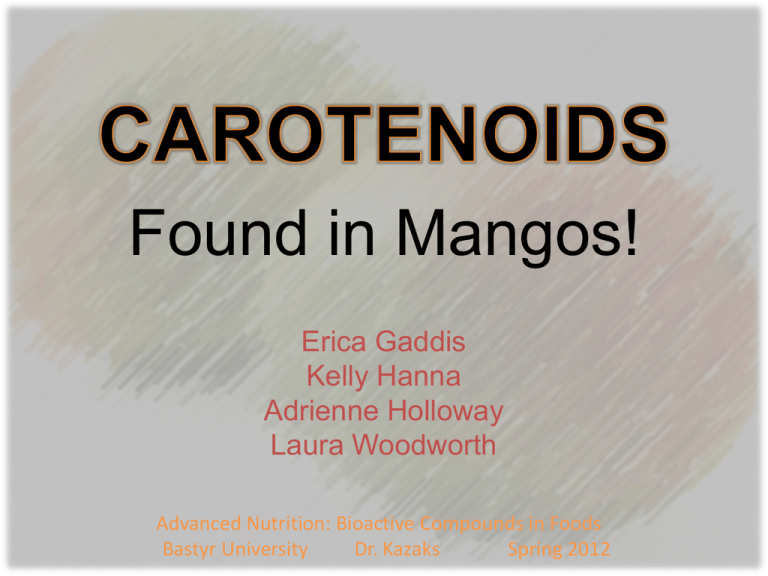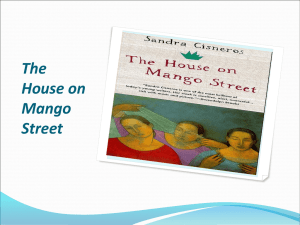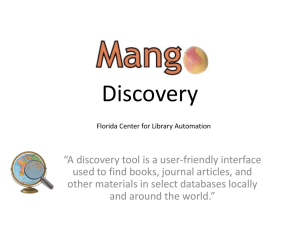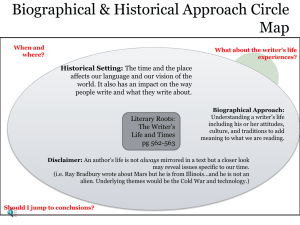carotenoidspresentation
advertisement

Found in Mangos! Erica Gaddis Kelly Hanna Adrienne Holloway Laura Woodworth Advanced Nutrition: Bioactive Compounds in Foods Bastyr University Dr. Kazaks Spring 2012 Mango History • Thought to originate from the Himalayan foothills of northeast India and North Burma • 16th century Portuguese voyagers brought mangos home • Portuguese took plants from Goa to southern Africa and Brazil • Muslim missionaries took mangos from Indochina to the islands of Sulu and Mindanao (present-day Phillippines) • Mid-20th century mangos reached Haiti, Dominican Republic, French Caribbean • Later 20th century mangos finally migrated to California, Florida, Hawaii, Mexico http://trec.ifas.ufl.edu/tfphotos/update12-05/glenn-mango3.jpg Scientific Study • high levels of phenolic compounds and carotenoids. • the mango’s possible chemopreventative properties • mango contains compounds that can inhibit the growth cycle of an immortal cancer cell line in vitro. • unknown whether these anticancer properties are maintained after digestion, absorption and metabolism. Percival S.S., Talcott S.T., Chin S.T., Mallak A.C., Lounds-Singleton A, and Pettit-Moore J. 2006. Neoplastic Transformation of BALB/3T3 Cells and Cell Cycle of HL-60 Cells are Inhibited by Mango (Mangifera indica L.) Juice and Mango Juice Extracts. J. Nutr.136: 1300–1304. Mangos are an important food • The “king of the fruit” • Organoleptically pleasing • Good sources of: – 100% daily Vitamin C – 35% daily Vitamin A – Vitamin B6 – Potassium, Copper – 12% daily Dietary Fiber http://images.pictureshunt.com/pics/m/mango-5516.jpg, http://www.mango.org/mango-fun-facts One Cup Sliced Mango Fruit: 107 Calories 101 kcals from Cho 3.7 from Fat 2.8 from Pro. Total Omega-3 fatty acids 61.1 mg Total Omega-6 fatty acids 23.1mg. That is a ratio of 3 to 1! Eating mango with a fat source improves carotenoid absorption in the SI. http://nutritiondata.self.com/facts/fruits-and-fruit-juices/1952/2, http://images.sodahead.com/polls/000331893/polls_boy_eating_mango_2313_144501_answer_2_xlarge.jpeg Mango health risks • People can be sensitive to mango skin or fruit • Mangiferol, a resinol in trunk sap and skin of unripe fruit, is potent skin irritant • Hypersensitive persons may dramatically react with swelling of eyelids, face, other body parts • Hypersensitive persons may react to skin, flesh or juice http://1.bp.blogspot.com/_hFrEQHx6r_M/SdV3WAFJ4iI/AAAAAAAAAFA/kyz9vwez0wU/s320/Mangoes_Mug.png http://trec.ifas.ufl.edu/tfphotos/update12-05/choc-anon-mango.jpg Carotenoid Content Raw Mangos Mean value* USA Canned Mangos Mean value* USA Mango, Ripe, Raw: Average value** Europe Alpha-carotene 17 mcg/100g none none Beta-carotene 445 mcg/100g (range 395-495 mcg/100 g) 13,120 mcg/100g 1300 mcg/100 g Beta-cryptoxanthin 11 mcg/100g 1550 mcg/100 g 54 mcg/100 g none contain lycopene, lutein, or zeaxanthin * Please see next slide for sources Carotenoid Content Resources *USDA-NCC Carotenoid Database for U.S. Foods – 1998 http://www.nal.usda.gov/fnic/foodcomp/Data/car98/car98.html **A European carotenoid database to assess carotenoid intakes and its use in a five-country comparative study O’Neill ME, Carroll Y, Corridan B, Olmedilla B, Granado F, Blanco I, et al. A European carotenoid database to assess carotenoid intakes and its use in a five-country comparative study. British Journal of Nutrition. 2001(85):499-507. http://journals.cambridge.org/download.php?file=%2FBJN%2FBJN85_04%2FS00071145010007 45a.pdf&code=d776a4bac83b2c75417e3dfa463249ff Variety 6 most common varieties in the USA: • Tommy Atkins - Fort Lauderdale, Florida, 1920’s • Haden – Coconut Grove, Florida 1910 • Kent – Coconut Grove, Florida 1944 • Keitt – Homestead, Florida 1945 • Ataulfo – Hawaiian seedling of Manila mango • Madam Francis - Haiti BIOAVAILABILITY Study comparing six varietals of mangoes in India: Beta-carotene content and bioaccessibility varied significantly. Growing Conditions Location: • Hot, tropical environment • Southern California, Florida • Mexico, Haiti, Caribbean, South America Species: • Evergreen family • Grow to 65-100 feet • Leaves ~16 inches long • White flower from which 1% form fruit BIOAVAILABILITY Growing location matters, even within same climate Growing Conditions Color variation: • Red = outside of tree • Yellow-green = shaded portion of tree • Does not indicate ripeness, maturity, quality • Maturation = 4 months Harvest: • Picked by hand in coolest part of day • Bruise-easily so great care is taken • Carefully transported to warehouse • In transport store between 50-54°F http://www.mango.org/sites/default/files/imagecache/530x340/images/rotator/Consumer_Landing_MangoFunFacts.jpg Storage and Processing: • Usually harvested unripe. Carotenoid content increases during ripening. BIOAVAILABILITY • Oxygen, light, heat, destruction of matrix reduces biological activity • Storage at 15°C vs 25° C: • Slower ripening, slower synthesis of carotenoids, longer shelf life Cooking Methods BIOAVAILABILITY • Interaction with Fat: Consuming dietary fat with carotenoids increases absorption • Liberation from Food Matrix: – Fresh slices or juice best – Heat from grinding may also help – Dried mangoes: Decreased bioavailability Carotenoid Shape Alpha-carotene Beta-carotene Beta-cryptoxanthin http://upload.wikimedia.org/wikipedia/commons/thumb/a/aa/Alpha-carotene.svg/620px-Alpha-carotene.svg.png http://upload.wikimedia.org/wikipedia/commons/thumb/2/27/Beta-Carotin.svg/792px-Beta-Carotin.svg.png http://upload.wikimedia.org/wikipedia/commons/thumb/9/96/Cryptoxanthin.png/800px-Cryptoxanthin.png Carotenoid Color http://www.ks.uiuc.edu/Research/psu/energy.jpg http://trec.ifas.ufl.edu/tfphotos/update12-05/glenn-mango2.jpg http://www.tropicalfruitnursery.com/mango/images/tommy-atkins-mango-photo-Ian-Maguire.jpg http://www.tropicalfruitnursery.com/mango/images/haden-mango-photo-Ian-Maguire.jpg http://www.tropicalfruitnursery.com/mango/images/kent-mango-photo-Ian-Maguire.jpg http://www.tropicalfruitnursery.com/mango/images/keitt-mango-photo-Ian-Maguire.jpg Ataulfo Mango http://www.fruitguys.com/email/images/3-4-11/ataulfo-mango-trans.png Francis Mango http://media.agriculturesource.com/product/imgage/Agriculture/2010080814/c378750ce63c71bd90560b4ac904f0a0.jpg Mango Seasons • Mexican mangos: March through September • Florida mangos May through September • Haitian mangos January through September • Brazilian mangos September through January http://t2.gstatic.com/images?q=tbn:ANd9GcQQpAhfPiJaK6ha9L9ufTRgB3gnT1iqxx7-hT-PyJcUWbRjmb3G0A Mangos Mango seed weevil • Hawaiian mangos prohibited in: mainland USA, Australia, Japan some other countries. http://t1.gstatic.com/images?q=tbn:ANd9GcTi4Y_Ihs7uJlL4gToj4i5BLExBq9jEyHahCr2WO19JlfTwNlUL5Ahttp://www.bitterrootrestorati on.com/images/botany/Diseases/new/stone_weevil.jpg Choose a Ripe Mango • Don’t focus on color. It is not the best indicator of ripeness. • Squeeze the mango gently. A ripe mango will be slightly soft to the touch. • A firmer mango would be a good choice if you don’t plan to eat it for several days. • Use your experience with produce such as peaches or avocados, which also become soft to the touch when ripe. • Ripe mangos will often have a fruity aroma at their stem ends. http://i171.photobucket.com/albums/u304/sandeepablog/MangoManthram11.jpg Cinco de Mango Salsa Preparation Time: 15 minutes Cooking Time: None Ingredients: 1 medium jalapeno pepper, stemmed, seeded and minced 2/3 cup diced red bell pepper 1/3 cup diced red onion 2 tablespoons chopped fresh cilantro 2 tablespoons fresh lime juice 1 tablespoon olive oil ½ teaspoon ground cumin ½ teaspoon kosher salt 3 large ripe mangos, peeled, pitted and diced Directions: Stir all ingredients together in a medium bowl. Spinach Salad with Mango Vinaigrette Preparation Time: -- minutes Cooking Time: None Spinach Salad Ingredients: 1(10 ounce) bag baby spinach 1 ½ ripe mangos, peeled, pitted and cubed 1 medium tomato, cored, seeded and finely chopped 1/3 cup walnuts, toasted and chopped 1/3 cup green onions, sliced 1/3 cup crumbled blue cheese freshly ground pepper to taste Spinach Salad with Mango Vinaigrette Mango Vinaigrette Ingredients: ½ mango, peeled, pitted and pureed 3tablespoons extra virgin olive oil 3 tablespoons white balsamic vinegar ¼ teaspoon salt To Prepare the Salad: Place spinach, mango, tomato walnuts and green onions in a large bowl. Drizzle with Mango Vinaigrette and toss well to coat. Add blue cheese and toss again very lightly. Serve immediately with freshly ground pepper. To Prepare the Mango Vinaigrette: Combine mango, extra virgin olive oil, white balsamic vinegar and salt in a blender container or small food processor; blend until smooth. How To Cut A Mango “Always wash the mango before cutting. • “Stand the mango on your cutting board stem end down and hold. Place your knife about 1/4" from the widest center line and cut down through the mango. Flip the mango around and repeat this cut on the other side. The resulting ovals of mango flesh are known as the "cheeks." What's left in the middle is mostly the mango seed. • “Cut parallel slices into the mango flesh, being careful not to cut through the skin. Turn the mango cheek 1/4 rotation and cut another set of parallel slices to make a checkerboard pattern. • “Here’s where you can choose your favorite method. Either “Slice and Scoop”—scoop the mango slices out of the mango skin using a large spoon—or “Inside Out”—turn the scored mango cheek inside out by pushing the skin up from underneath, and scrape the mango chunks off of the skin with a knife or spoon. • “Hint: If you are making a recipe that calls for diced mango, make your cuts in step 2 closer together. The result is small pieces of diced mango and no need to further cut up the mango pieces on your cutting board.” http://www.mango.org/how-cut-mango Ways to Prepare Mangos • Chopping: cut into pieces, added to salads and dishes to create a fresh light flavor. • Pureeing: pureed mango pulp added to sweet dishes like ice creams, custards and various sweet dishes. • Pickling: popular method of use; add mustard oil or vinegar to pickled mango. • Drying: powder form called “amchur”, widely used spice in Indian cuisine. Mango Fun Facts • Leaves contain glucoside & mangiferine. • Feeding mango leaves to cows allowed Indians to use their bright yellow urine containing euxanthic acid as a fabric dye. (This can be fatal for cows and is no longer legal) • Indian paisley pattern based on mango shape. • Mango is symbol of love in India • Mangos related to cashews and pistachios More Mango Fun Facts • • • • • • • • • “Mangos are the most popular fruit in the World” “Mangos were first grown in India over 5,000 years ago” “Mango seeds traveled with humans from Asia to the Middle East, East Africa and South America beginning around 300 or 400 A.D.” “The paisley pattern, developed in India, is based on the shape of a mango” “The mango is a symbol of love in India, and a basket of mangos is considered a gesture of friendship” “Legend says that Buddha meditated under the cool shade of a mango tree” “Mangos are related to cashews and pistachios” “A mango tree can grow as tall as 100 feet” “The bark, leaves, skin and pit of the mango have been used in folk remedies for centuries” http://www.mango.org/mango-fun-facts Resources Mango background addapted from: http://www.dole.com/servedocument.aspx?fp=images/ MigratedContent/Dole/EatRight/webservices/ DoleMediaLibraryRoot/productimages/freshfruit/Mangoes_F3.jpg This page corner mango image: http://images.pictureshunt.com/pics/m/mango-5516.jpg http://themangofactory.com/mango-articles2/origin-and-distribution/) http://themangofactory.com/mango-articles2/mango-toxicity-to-hypersensitivepersons/ http://themangofactory.com/mango-articles2/selecting-handling-mangoes/) http://nutritiondata.self.com/facts/fruits-and-fruit-juices/1952/2 Percival S.S., Talcott S.T., Chin S.T., Mallak A.C., Lounds-Singleton A, and PettitMoore J. 2006. Neoplastic Transformation of BALB/3T3 Cells and Cell Cycle of HL60 Cells are Inhibited by Mango (Mangifera Slide show background theme designed by Erica Gaddis Resources continued Mango bioavailability Resources: www.mango.org www.freshmangos.com www.crfg.org/pubs/ff/mango.html http://en.wikepedia.org/wiki/Mango Veda S, Platel K, Srinivasan K. Varietal differences in the bioaccessibility of beta-carotene from mango (Mangifera indica) and papaya (Carica papaya) fruits. J Agric Food Chem. 2007 Sep 19;55(19):7931-5. Gouado I, Schweigert FJ, Ejoh RA, Tchouanquep MF, Camp JV. Systemic levels of carotenoids from mangoes and papaya consumed in three forms (juice, fresh and dry slice). Eur J Clin Nutr. 2007 Oct;61(10):1180-8. Muoki PN, Makokha AO, Onyango CA and Ojijo NKO. EFFECT OF TEMPERATURE, MATURITY AND GEOGRAPHICAL LOCATION ON THE Β-CAROTENE AND TOTAL CAROTENOID CONTENT OF SOME MANGO (MANGIFERA INDICA) CULTIVARS GROWN IN KENYA. http://jkuat.academia.edu/OjijoNelsonKennedyOlango/Papers/1438472/EFFECT_OF_TEMPE RATURE_MATURITY_AND_GEOGRAPHICAL_LOCATION_ON_THE_B-CAROTENE AND TOTAL CAROTENOID CONTENT OF SOME_ TR 5140 Bioactive Foods Project and Presentation 40 points Each group will select a food item that is an important source of a bioactive from the groups indicated for each week of presentations. (There are other foods that may belong to the groups. The examples are not the only foods you can choose.) Prepare a fact sheet about that food item that would be suitable to give a client or patient who wants to know more about bioactive components in foods. It may be more than one page, but should be easily readable, as during a counseling session. Requirements to include in the fact sheet: (20 points) Why your food is important to health. Include brief information and the reference citation from a scientific study. Describe any health risks that may be associated with the food. Using a nutrient database, describe the content of your bioactive compound of interest in your food. Include a link to the database. Describe the availability of the food in the marketplace. Discuss the bioavailability of the compound in the food as it relates to: Variety Growing conditions Storage and processing Cooking method Include a reference citation for where you got these facts. Include a recipe that uses the food in a manner that provides optimal bioavailability. Overall impression (5 points) Information is accurate and factual Research and citations are relevant to food item Fact sheet is easy to follow, shows creativity and is attractive Fact sheet includes at least one graphic, picture or chart Prepare a presentation based upon the information from your fact sheet to present to class members. (15 points) This should take about 20 minutes to present. (3 points) Propose a question or idea about your food and its bioactives and use it to lead a short discussion with class members at the end of your presentation. (3 points) Provide a small sample of your food item for class members to taste. (5 points) Overall impression (4 points) Presentation shows evidence of group preparation Class discussion shows knowledge of subject Strategies: Decide how the group work will be carried out. Divide the responsibilities. You will have to do some research to find the information you need. Please include citations for any material you use. You can use a separate sheet if you do not want to put extra citations on the patient/client fact sheet. http://themangofactory.com/ http://t3.gstatic.com/images?q=tbn:ANd9GcRGceq9gZOlH9_QVtkMSFGGx7YhjkwT1j5xmdvQ6-TXn5iqblC8Bw






